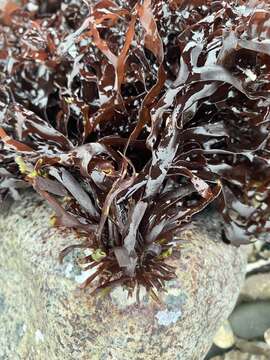
Mazzaella japonica
Algae
Mazzaella japonica is a red seaweed native to the Northwest Pacific, including the countries around the Sea of Japan (China, Korea, Japan, Russia). We consider a 1960 record from Adak Island, in the Aleutians, to be cryptogenic. The date of its invasion in British Columbia is not certain, but an herbarium specimen from the Strait of Georgia dates from 2005. It is possible that it was introduced with Pacific Oysters from Japan in the early 20th century. Eleven species of Mazzaella are known from British Columbia, so genetic identification was needed to confirm its status. This seaweed has also been collected in Peru and Chile, as early as 1913 in Chile and 1950 in Peru. Mazzaella japonica begins growth from a narrow holdfast, and forms a spreading blade which becomes ruffled and finely subdivided, and dark reddish to purplish in color. This alga grows in the lower intertidal and shallow subtidal. Since 2000, it has formed massive deposits of wrack on beaches, with negative visual and olfactory impacts, but is also harvested for carrageenan, a polysaccharide used in food processing. However, commercial harvesting has its own aesthetic and ecological impacts, with vehicles removing tons of seaweed. To our knowledge, this species has not been found in US waters, though it occurs close to the border with Washington. In its native range, Mazzaella japonica is cultivated as a 'sea vegetable'.